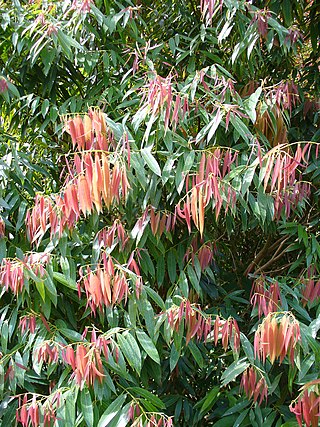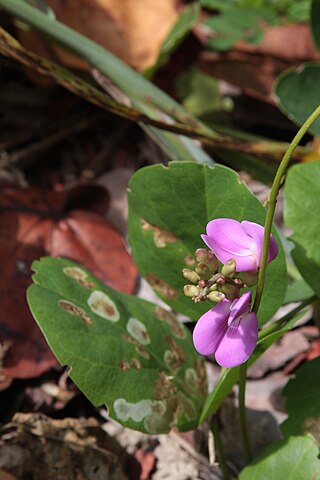
Mesua is a genus of flowering plants in the family Calophyllaceae, native to tropical southern Asia. Common names include ironwood and rose chestnut.

Kayea is a plant genus in the family Calophyllaceae. Its species range from Bangladesh and the eastern Himalayas to Sri Lanka, Indochina, Peninsular Malaysia, Borneo, Sumatra, the Philippines, New Guinea, and Queensland.

Dipteryx is a genus containing a number of species of large trees and possibly shrubs. It belongs to the "papilionoid" subfamily – Faboideae – of the family Fabaceae. This genus is native to South and Central America and the Caribbean. Formerly, the related genus Taralea was included in Dipteryx.

Cupaniopsis is a genus of about 67 species of trees and shrubs of the soapberry family, Sapindaceae. They grow naturally in New Guinea, New Caledonia, Australia, Torres Strait Islands, Fiji, Samoa, Sulawesi, Micronesia. Many species have been threatened with extinction globally or nationally, with official recognition by the International Union for Conservation of Nature (IUCN) and several national and state governments.

Phyla nodiflora, the frog fruit, sawtooth fogfruit, or turkey tangle, is a flowering plant in the family Verbenaceae, and is native to the area from northern South America to southern United States. It can be found in tropical areas around the globe, a naturalized species in many places. This plant is cited in Flora Brasiliensis by Carl Friedrich Philipp von Martius.

Dipteryx charapilla is a little-known species of flowering plant in the family Fabaceae, a large to mid-sized tree growing along rivers in the rainforests of Brazil. and Peru.
Kayea coriacea is a species of flowering plant in the Calophyllaceae family. It is found only in Papua New Guinea.
Kayea macrophylla is a species of flowering plant in the family Calophyllaceae. It is found in West Papua (Indonesia) and Papua New Guinea.
Kayea daphnifolia is a species of flowering plant in the family Calophyllaceae. It is a tree endemic to Peninsular Malaysia.
Kayea manii is a species of flowering plant in the Calophyllaceae family. It is found only on South Andaman Island in India. It is threatened by habitat loss.

Mesua stylosa is a species of flowering plant in the Calophyllaceae family. It is a tree endemic to southwestern Sri Lanka.
Gabbiella rosea is a species of small freshwater snails with an operculum, aquatic prosobranch gastropod mollusks in the family Bithyniidae.

Partula rosea is a species of air-breathing tropical land snail, a terrestrial pulmonate gastropod mollusk in the family Partulidae.

Bersama abyssinica is a species of medium-sized evergreen tree in the Francoaceae family. The leaves are pinnately divided with a strongly winged rachis. The inflorescence is a spike.
Gaertnera rosea is a species of plant in the family Rubiaceae. It is endemic to Sri Lanka.

Cylindropuntia rosea, the Hudson pear, is a cactus native to the Sonoran Desert in Arizona and Northwestern Mexico. The plant is an invasive species in Australia.

Canavalia rosea is a species of flowering plant of the genus Canavalia in the pea family of Fabaceae, it has a pantropical and subtropical distribution in upper beaches, cliffs, and dunes. Common names include beach bean, bay bean, sea bean, greater sea bean, seaside jack-bean, coastal jack-bean, and MacKenzie bean.

Nephropsis rosea, sometimes called the rosy lobsterette or two-toned lobsterette, is a species of lobster.

Clusia rosea, the autograph tree, copey, cupey, balsam apple, pitch-apple, and Scotch attorney, is a tropical and sub-tropical flowering plant species in the family Clusiaceae. The name Clusia major is sometimes misapplied to this species.













